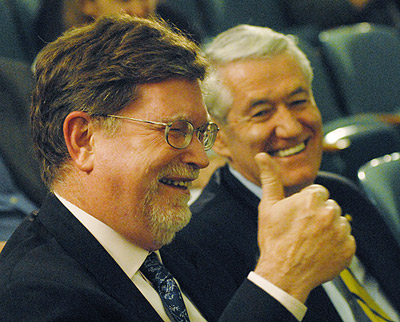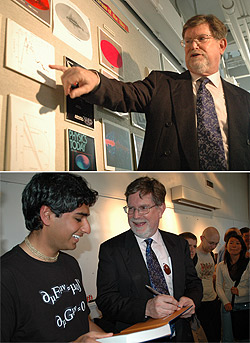Berkeleyan
 |
George Smoot (left) showed his appreciation for compliments from the dais at his Lawrence Berkeley National Lab press conference on Tuesday. Chancellor Birgeneau, seated with him, was one of many who enjoyed Smoot's "great day." (Peg Skorpinski photo) |
Smoot extends Berkeley's Nobel tradition
Physicist shares this year's prize for his work confirming aspects of the Big Bang
![]()
| 04 October 2006
Tuesday was, as Chancellor Robert Birgeneau put it, "a great day for Berkeley and Berkeley Lab" as the campus, the UC system, and Big Bang aficionados the world over cheered cosmologist and astrophysicist George Smoot for winning the 2006 Nobel Prize in physics.
|
• Praise for George Smoot: "We're surprised and delighted" • A Nobel morning: Slide show • Press conference webcast • The lighter side of a Nobel Prize • Nobel press release from the Royal Swedish Academy of Sciences • George Smoot biography • Smoot Group — Astrophysics & Cosmology • COBE — Cosmic Background Explorer project • Skymaps: Images of the early universe • UC Berkeley Physics Department faculty site • LBL scientists detect seeds of the modern universe LBNL 5.1.92 • A Nobel week, so far: The Berkeley connection  • NASA scientist and Berkeley alum John Mather shares Nobel Prize for physics • NASA scientist and Berkeley alum John Mather shares Nobel Prize for physics• Downloadable photos |
The experiments - conducted via NASA's Cosmic Background Explorer (COBE) satellite - "really confirmed our picture of the Big Bang," Smoot said hours after being awakened at his home in the Berkeley hills by an early-morning call from Stockholm. "By studying the fluctuations in the microwave background, we found a tool that allowed us to explore the early universe, to see how it evolved and what it's made of."
Astrophysicist Eric Linder, an LBNL colleague, remembered being at the meeting of the American Physical Society on May 1, 1992, when Smoot announced his team's findings. "The data and the presentation were just so elegant, so beautiful, that everyone started applauding," Linder said. "It was an incredibly hard experiment to do. He received a standing ovation."
On Tuesday, Smoot was again the recipient of rousing acclaim - not only for the Nobel committee's recognition of his role in furthering understanding of the origins of the universe, but as a dedicated teacher of undergraduate physics and a collegial co-worker. Richard Marrus, an emeritus professor of physics, called him "a very open, low-key, friendly guy," adding that "he's fun to interact with."
Marjorie Shapiro, the chair of Berkeley's physics department, noting Smoot's active role in recruiting new physics students to the campus, said the Nobel "sends a message that UC Berkeley is a first-rate institution for doing research, that we're doing state-of-the-art work in the most exciting areas of physics."
"All department chairs think their faculty are exceptional. It's wonderful when the rest of the world tells you that you're right," Shapiro said, adding, "I think he was more surprised than anyone else in this department."
 Not yet midway through a very busy day, Smoot paused in the hallways of LBNL to show reporters a display explaining his research. Not long after, he autographed a textbook for an admiring student whose T-shirt spoke their common language. (Top photo by Peg Skorpinski, bottom photo by Jeffery Kahn) |
In fact, Smoot reported, he was downright skeptical. "Some guy from the Swedish Academy" called his cell phone at around 2:45 a.m., he said at a pair of news conferences later in the day, and Smoot demanded to know how the caller had gotten his number, which is unlisted. "At first I thought I'd better be careful, this could be a hoax. But the guy sounded really serious, and he had a Swedish accent."
Even so, he turned on his computer to confirm the news, to find "nothing there" about his winning the prize. Only after a few calls from people he knows personally - by which time the news had appeared on the Web - did he believe it.
Smoot called winning the Nobel "a great thrill," but said it was "not quite the same thrill as making the discovery, and having to keep it secret for months before we made the announcement."
For those attempting to describe the nature of that discovery Tuesday, variations on the word "profound" cropped up repeatedly. "George led the experiment that found the quantum seeds of all the structure that we see in the universe," explained Adrian Lee, an associate professor of physics at Berkeley. "That work is a cornerstone for our current model of cosmology, where the universe starts in a Big Bang and then gravity grows these seeds into all the structures that we see in the universe today. George's work has had a profound effect on our understanding of the universe."
Birgeneau, a physicist who was a member of the faculty at MIT in 1992, called the research "profoundly important work."
"The experiment for which the Nobel Prize is being awarded represents a technical tour de force that successfully probes the most fundamental aspects of the universe," said the beaming chancellor. "This work is at the heart of understanding the origin and evolution of the universe, moving cosmology from the realm of theory to experimentation."
Smoot himself likened the experiment to the ringing of the carillon in the Campanile. If you listen to a bell long enough, he explained, "you'll be able to tell if it's a brass bell, or a steel bell, or an iron bell. And what we're looking at with these fluctuations" - that is, the minuscule variations in temperature that Smoot, Mather, and their team found were produced when the universe was not yet the size of a proton - "is the ringing of the early universe."
The results, he said, provided cosmologists with a tool to create a map of the universe "from a time when the universe was merely 400,000 years old." In human terms - given that the universe came into existence some 14 billion years ago - "that's like an embryo at a few hours old."
Reality in cosmology
From Wrinkles in Time by George Smoot. Copyright © 1993 by George Smoot. By permission of Harper Collins Publishers. |
"We're really in a different regime, where we're understanding not only what the universe looked like when it was an embryo" but its constituent parts, he said, "so that we can predict its whole development and understand it. And to me, that's the really exciting part."
As for his newfound celebrity, Smoot said he viewed it with mixed emotions. "I am worried about how this changes my life," he acknowledged. "I talked to Chu about it" - Steve Chu, LBNL's director and a Nobel laureate himself - "and he said it's up to me. On the other hand, Birgeneau had a list of things that I could come and do this week," including handling the coin flip at this Saturday's Homecoming game against Oregon. Smoot said he hopes he's able to find a balance between giving back to the university and the lab - "a tremendously wonderful environment, both for education and for research" - and making further scientific discoveries. "So I don't know what's going to happen," he said. "It's going to be an experiment for me."
Birgeneau, promising to "take advantage" of Smoot's heightened visibility and prestige as a Nobelist at a public research university, made a special point of praising his role in advancing the educations of undergrads. Smoot, said Birgeneau, is "a great researcher, obviously, as recognized by the Nobel committee," but he's "also someone who's in the classroom teaching undergraduates every Monday, Wednesday, and Friday at 11 a.m."
"He's the kind of faculty member who gives our undergraduates the opportunity of pursuing knowledge at its very frontier," said the chancellor, citing the four undergrads who work in Smoot's lab. "There are not many places where that can happen, and not many places have the kind of faculty members who do Nobel Prize work and include undergraduates in that work."
Martin White, a professor of physics and astronomy, was among the colleagues applauding Smoot for his scientific contributions, calling the 1992 announcement "a huge deal" that "transformed cosmology overnight..It got a lot of young people excited, and they got into the field, and the field really took off."
For all the excitement over the birth of the universe, though, it seemed that few lost sight of perhaps the best-known benefit of being a Berkeley Nobelist.
"You might point out that getting a personalized parking place on campus for free is one of the important perks," suggested Richard Marrus, the emeritus physics prof.


